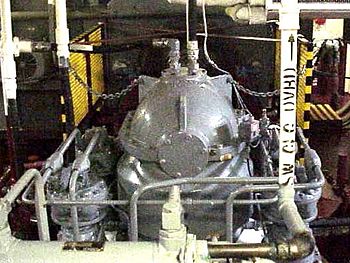Z drive: Difference between revisions
imported>George Swan (first draft on citizendium) |
imported>Meg Taylor (update template) |
||
| (2 intermediate revisions by one other user not shown) | |||
| Line 1: | Line 1: | ||
{{subpages}} | {{subpages}} | ||
The '''Z-drive''' is a specialized form of [[marine propulsion]]. | [[Image:RV Ron Brown Z drive 1.jpg|right|thumb|350px|{{#ifexist:Template:RV Ron Brown Z drive 1.jpg/credit|{{RV Ron Brown Z drive 1.jpg/credit}}<br/>|}} Inboard portion of the Z-drive's transmission on the [[research vessel Ron Brown]]. This is the upper, inboard knuckle joint. The drive shaft emerges from the diesel engine directly behind this knuckle joint.]] | ||
The '''Z-drive''' is a specialized form of [[marine propulsion]].<ref name=NoaaLog20020902> | |||
{{cite news | |||
| url=http://www.ogp.noaa.gov/epic/daily/3week/index.htm | |||
| title=We are the Ronald H. Brown–The Engine Room | |||
| publisher=[[NOAA]] | |||
| author=Lisa M. Weiss, Watershed Coordinator Jacques Cousteau National Estuarine Research Reserve | |||
| date=September 2, 2002 | |||
| accessdate=2007-11-17 | |||
}}</ref> | |||
With a Z drive a vessel doesn't have conventional propellers at the end of fixed propeller shafts. Instead they mount propellers on pods that emerge from the bottom of the vessel. The pods can be oriented through a full 360 degrees, allowing rapid changes in the direction of thrust. Z-drive equipped vessels don't need a conventional rudder. | |||
This form of propulsion is called a Z-drive because, when the propeller is mechanically powered, the rotary motion has to make two right angle turns -- thus looking a bit like the letter "''Z''". | This form of propulsion is called a Z-drive because, when the propeller is mechanically powered, the rotary motion has to make two right angle turns -- thus looking a bit like the letter "''Z''". In contrast the propulsion system known as an [[azipod]] also mounts a propeller at the end of pod that can be oriented through 360 degrees, but the propeller is powered by an electric motor in the pod itself. | ||
The | The maneuverability provided to vessels by the Z drive system can be particularly useful to ferries, harbor tugs and fireboats. | ||
[[ | The [[Voith-Schneider marine propulsion system]] can also quickly change the direction of thrust. | ||
Vessels equipped with these kinds of propulsion systems don't need conventional [[rudder]]s. | |||
==References== | |||
{{reflist}} | |||
Latest revision as of 10:05, 21 September 2013

Inboard portion of the Z-drive's transmission on the research vessel Ron Brown. This is the upper, inboard knuckle joint. The drive shaft emerges from the diesel engine directly behind this knuckle joint.
The Z-drive is a specialized form of marine propulsion.[1] With a Z drive a vessel doesn't have conventional propellers at the end of fixed propeller shafts. Instead they mount propellers on pods that emerge from the bottom of the vessel. The pods can be oriented through a full 360 degrees, allowing rapid changes in the direction of thrust. Z-drive equipped vessels don't need a conventional rudder.
This form of propulsion is called a Z-drive because, when the propeller is mechanically powered, the rotary motion has to make two right angle turns -- thus looking a bit like the letter "Z". In contrast the propulsion system known as an azipod also mounts a propeller at the end of pod that can be oriented through 360 degrees, but the propeller is powered by an electric motor in the pod itself.
The maneuverability provided to vessels by the Z drive system can be particularly useful to ferries, harbor tugs and fireboats.
The Voith-Schneider marine propulsion system can also quickly change the direction of thrust.
Vessels equipped with these kinds of propulsion systems don't need conventional rudders.
References
- ↑ Lisa M. Weiss, Watershed Coordinator Jacques Cousteau National Estuarine Research Reserve. We are the Ronald H. Brown–The Engine Room, NOAA, September 2, 2002. Retrieved on 2007-11-17.